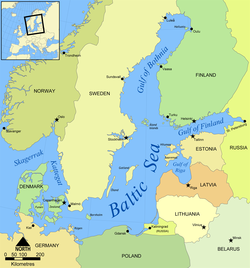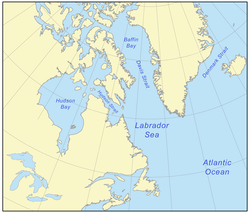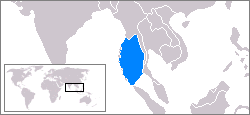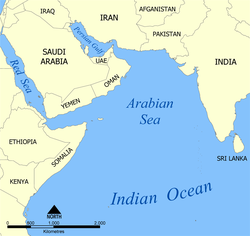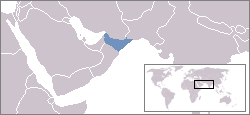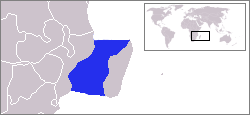A fishery is an area with an associated fish or aquatic population which is harvested for its commercial value. Fisheries can be wild or farmed. Most of the world's wild fisheries are in the ocean. This article is an overview of ocean fisheries.
Statistics
[edit]Oceans occupy 71 percent of the Earth's surface. They are divided into five major oceans, which in decreasing order of size are: the Pacific Ocean, Atlantic Ocean, Indian Ocean, Southern Ocean, and Arctic Ocean. Over 70 percent of the world catch from the sea comes from the Pacific Ocean.
| Ocean metrics | |||||||||
|---|---|---|---|---|---|---|---|---|---|
| Ocean | Area million km2 |
% | Volume[1] million cu km |
% | Mean depth km |
Max depth km |
Coastline km |
Fish capture[2] million tonnes |
% |
| Pacific Ocean[3] | 155.6 | 46.4 | 679.6 | 49.6 | 4.37 | 10.924 | 135,663 | 84.234 | 71.0 |
| Atlantic Ocean[4] | 76.8 | 22.9 | 313.4 | 22.5 | 4.08 | 8.605 | 111,866 | 24.045 | 20.3 |
| Indian Ocean[5] | 68.6 | 20.4 | 269.3 | 19.6 | 3.93 | 7.258 | 66,526 | 10.197 | 8.6 |
| Southern Ocean[6] | 20.3 | 6.1 | 91.5 | 6.7 | 4.51 | 7.235 | 17,968 | 0.147 | 0.1 |
| Arctic Ocean[7] | 14.1 | 4.2 | 17.0 | 1.2 | 1.21 | 4.665 | 45,389 | ||
| Totals | 335.3 | 1370.8[8] | 4.09 | 10.924 | 356,000 | 118.623 | |||
Pacific Ocean
[edit] The Pacific Ocean is the largest of the world's oceans, extending from the Arctic in the north to Antarctica in the south. Covering 169.2 million square kilometers, it is larger than all of the Earth's land area combined.[9] The Pacific contains 25,000 islands (over half the islands in the world), most of which are south of the equator. The Pacific's greatest asset is its fish. The shoreline waters of the continents and the more temperate islands yield herring, salmon, sardines, snapper, swordfish, and tuna, as well as shellfish. |
| Pacific seas : Statistics | |||||||
|---|---|---|---|---|---|---|---|
| Region | Area million km2 |
Volume million cu km |
Mean depth km |
Max depth km |
Coastline km |
Fish harvest million tonnes |
Percent of total |
| Celebes Sea | 0.280 | 6.2 | |||||
| Coral Sea | |||||||
| East China Sea | 1.249 | ||||||
| Philippine Sea | |||||||
| Sea of Japan | 0.978 | 1.753 | 3.742 | ||||
| South China Sea | 3.5 | ||||||
| Sulu Sea | |||||||
| Tasman Sea | |||||||
| Yellow Sea | |||||||
| Pacific seas: Maps and descriptions |
|---|
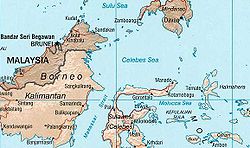 The Celebes Sea has warm clear waters and harbors about 580 of the world's 793 species of reef-building corals, which grow as some of the most bio-diverse coral reefs in the world, and an impressive array of marine life, including whales and dolphins, sea turtles, manta rays, eagle rays, barracuda, marlin and other reef and pelagic species. Tuna and yellow fin tuna are also abundant. The sea also yields other aquatic products like sea tang. |
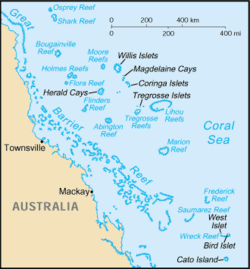 The Coral Sea is an ecologically important source of coral.[10] |
 The East China Sea. |
 The Philippine Sea. |
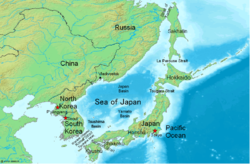 The Sea of Japan. Like the Mediterranean Sea, it has almost no tides due to its nearly complete enclosure.[11] It has an area of 978,000 square kilometre, a mean depth of 1,753 meters, and a maximum depth of 3,742 meters.
|
 The South China Sea is the repository of large sediment volumes delivered by the Mekong River, Red River and Pearl River. Within the sea, there are over 200 identified islands and reefs, including a 100 km wide seamount with a depth of 20 m and an area of 8,866 km2. According to studies made by the Department of Environment and Natural Resources, Philippines, this body of water holds one third of the all world's marine biodiversity, thereby making it a very important area for the ecosystem. |
 The Sulu Sea. |
 The Tasman Sea features a number of coastal islands and mid-sea island groups. |
 The Yellow Sea |
Atlantic Ocean
[edit]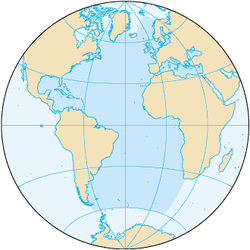 The Atlantic Ocean is the second-largest ocean covering 106.4 million square kilometres with a coastline of 111,000 kilometres. It occupies about one-fifth of the Earth's surface. The ocean has some of the world's richest fishing resources, especially in the waters covering the shelves. The major species of fish caught are cod, haddock, hake, herring, and mackerel. The most productive areas include the Grand Banks of Newfoundland, the shelf area off Nova Scotia, Georges Bank off Cape Cod, the Bahama Banks, the waters around Iceland, the Irish Sea, the Dogger Bank of the North Sea, and the Falkland Banks. Eel, lobster, and whales have also been taken in great quantities. Because of the threats to the ocean environment presented by oil spills, marine debris, and the incineration of toxic wastes at sea, various international treaties exist to reduce some forms of pollution.
| |||||||||||||||||||||||||||||||||||||||||||||||||||||||||||||||||||||||||||||||||||||||||||||||
Indian Ocean
[edit]
The ocean's continental shelves are narrow, averaging 200 kilometres (120 mi) in width. An exception is found off Australia's western coast, where the shelf width exceeds 1,000 kilometres (620 mi). The average depth of the ocean is 3,890 metres (12,760 feet). The remaining 14% is layered with terrigenous sediments. Glacial outwash dominates the extreme southern latitudes. The warmth of the Indian Ocean keeps phytoplankton production low, except along the northern fringes and in a few scattered spots elsewhere; life in the ocean is thus limited. Fishing is confined to subsistence levels. Its fish are of great and growing importance to the bordering countries for domestic consumption and export. Fishing fleets from Russia, Japan, South Korea, and Taiwan also exploit the Indian Ocean, mainly for shrimp and tuna. Endangered marine species include the dugong, seals, turtles, and whales. Oil and ship pollution threatens the Arabian Sea, Persian Gulf, and Red Sea.
| |||||||||||||||||||||||||||||||||||||||||||||||||||||||||||||||||||||||||||||||||||||||||||||||||||||||||||
Southern Ocean
[edit]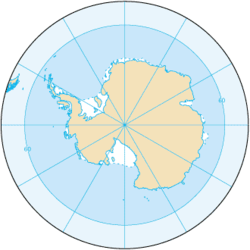 The Southern Ocean is the fourth-largest ocean, covering 20,327,000 square kilometers. It is typically between 4,000 and 5,000 meters deep with only limited areas of shallow water. The Antarctic continental shelf is narrow and unusually deep, its edge lying at up to 800 meters, compared to a global mean of 133 meters. The Antarctic Circumpolar Current moves perpetually eastward — chasing and joining itself, and at 21,000 kilometers is the world's longest ocean current, transporting 130 million cubic meters per second — 100 times the flow of all the world's rivers. The Antarctic ice pack fluctuates from an average minimum of 2.6 million square kilometers in March to about 18.8 million square kilometers in September. Fauna: squid, whales, seals, krill, various fish Increased solar ultraviolet radiation resulting from the Antarctic ozone hole has reduced marine primary productivity (phytoplankton) by as much as 15% and has started damaging the DNA of some fish[citation needed]. Illegal, unreported, and unregulated fishing, especially the landing of an estimated five to six times more Patagonian toothfish than the regulated fishery, likely affects the sustainability of the stock.[35] Long-line fishing for toothfish causes a high incidence of seabird mortality. The International Whaling Commission prohibits commercial whaling south of 40 degrees south (south of 60 degrees south between 50 degrees and 130 degrees west). Japan does not recognize this and they carry out an annual whale-hunt which they say is for scientific research. See Southern Ocean Whale Sanctuary. The Convention for the Conservation of Antarctic Seals has limited seal-hunting. The Convention on the Conservation of Antarctic Marine Living Resources regulates fishing in the region. |
| Southern seas : Statistics | |||||||
|---|---|---|---|---|---|---|---|
| Region | Area million km2 |
Volume million cu km |
Mean depth km |
Max depth km |
Coastline km |
Fish harvest million tonnes |
Percent of total |
| Amundsen Sea | |||||||
| Bellingshausen Sea | |||||||
| Ross Sea | |||||||
| Cooperation Sea | |||||||
| Cosmonaut Sea | |||||||
| Weddell Sea | |||||||
| Southern seas: Maps and descriptions |
|---|
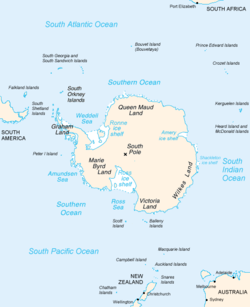 The Amundsen Sea is an arm of the Southern Ocean off Marie Byrd Land in western Antarctica. It is mostly ice-covered, averaging about 3 km (1.9 mi) in thickness and roughly the size of Texas. |
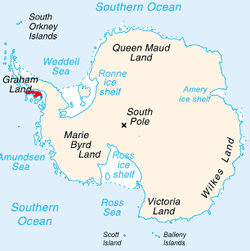 The Bellingshausen Sea is an area along the west side of the Antarctic Peninsula between Alexander Island and Thurston Island. |
 The Ross Sea is a deep bay of the Southern Ocean in Antarctica between Victoria Land and Marie Byrd Land. The southern part is covered by the Ross Ice Shelf. In the west of the Ross sea, McMurdo Sound is a port which is usually free of ice during the summer. A 10-metre (32.8 feet) long colossal squid weighing 495 kilograms (1,091 lb) was captured in the Ross Sea on 22 February 2007.
There are two main species of toothfish: the Patagonian toothfish, Dissostichus eleginoides, which occurs mainly in Subantarctic waters, and the Antarctic toothfish, D. mawsoni, which is found only in Antarctic waters. The Antarctic toothfish is caught from the Polar Convergence (at about 60° S) south to the Antarctic continent, whereas the Patagonian toothfish is mainly caught north of 65° S. The Ross Sea region is unusual because between these latitudes both species are abundant and show considerable overlap in their distribution. Indeed, over 90% of the longlines set in the fishery in this area have both species on the same line. Both species are found down to depths of over 2000 m The Ross Sea toothfish fishery is the southernmost fishery in the world. The extreme cold and ice conditions can make fishing both difficult and dangerous. During most of the year the Ross Sea itself is covered by ice. However, during January and February, areas of open water (called polynas) allow access to the continental shelf and slope. Longline vessels (predominantly from New Zealand, but also from South Africa, Russia, and Uruguay) have taken advantage of this to develop an exploratory fishery. They start working in the deep south, and as the season progresses they move north to stay ahead of the freezing sea ice, and by May are restricted to the northernmost fishing grounds. CCAMLR agrees on annual precautionary catch limits. Since 1998, the catch has steadily increased from about 40 t to over 1350 t in 2002 (all of these catches are well within the CCAMLR limits). Because it is a high latitude fishery, Antarctic toothfish has formed over 95% of the catch. Up to three New Zealand vessels have been involved in the fishery in any year. However, in the 2003 season up to six New Zealand vessels are fishing in these waters.[36] |
| The Cooperation Sea |
| The Cosmonaut Sea |
 The Weddell Sea land boundaries are defined by the bay formed from the coasts of Coats Land and the Antarctic Peninsula. Much of the southern part of the sea, up to Elephant Island, is permanent ice, the Filchner-Ronne Ice Shelf. At its widest the sea is around 2,000 km across, in area it is around 2.8 million km2. The ice shelves which used to extend roughly 3,900 square miles (10,000 km2) over the Weddell Sea have completely disappeared by 2002. |
Arctic Ocean
[edit] The Arctic Ocean is the smallest of the world's five major oceans and the shallowest.[37] Almost completely surrounded by Eurasia and North America, it is largely covered by sea ice throughout the year. Its temperature and salinity vary seasonally as the ice cover melts and freezes;[38] its salinity is the lowest on average of the five major seas, due to low evaporation, heavy freshwater inflow from rivers and streams, and limited connection and outflow to surrounding oceanic waters with higher salinities. In summer the icepack shrinks about fifty percent.[37] Endangered marine species include walruses and whales. The area has a fragile ecosystem which is slow to change and slow to recover from disruptions or damage. The Arctic Ocean has relatively little plant life except for phytoplankton. Phytoplankton are a crucial part of the ocean and there are massive amounts of them in the Arctic. Nutrients from rivers and the currents of the Atlantic and Pacific oceans provide food for the Arctic phytoplankton.[39] |
See also
[edit]- Wild fisheries
- World fish production
- Fishing by country
- List of harvested aquatic animals by weight
- Population dynamics of fisheries
- Krill fishery
- Crab fisheries
Notes
[edit]- ^ The World's Oceans and Seas. Archived 2006-02-24 at the Wayback Machine Encarta. Retrieved 19 April 2008.
- ^ FAO 2005 statistics: Fisheries and Aquaculture. Includes fish, crustaceans, and molluscs, does not include marine mammals or aquatic plants.
- ^ CIA Factbook: Pacific ocean.
- ^ CIA Factbook: Atlantic ocean.
- ^ CIA Factbook: Indian ocean.
- ^ CIA Factbook: Southern ocean.
- ^ CIA Factbook: Arctic ocean.
- ^ Elert, Glenn Volume of Earth's Oceans. The Physics Factbook. Retrieved 19 April 2008.
- ^ "Pacific Ocean". Britannica Concise. 2006. Chicago: Encyclopædia Britannica, Inc.
- ^ Hopley, David; Smithers, Scott G.; Parnell, Kevin E. (2007). The geomorphology of the Great Barrier Reef : development, diversity, and change. Cambridge : Cambridge University Press. p. 27. ISBN 978-0-521-85302-6.
{{cite book}}: CS1 maint: publisher location (link) - ^ "Tides in Marginal, Semi-Enclosed and Coastal Seas - Part I: Sea Surface Height". ERC-Stennis at Mississippi State University. Archived from the original on 2004-03-18. Retrieved 2007-02-02.
- ^ Bleaching Threatens Caribbean Coral Reefs. CBS News. URL accessed on April 29, 2006.
- ^ Alarm sounded for Caribbean coral. BBC News. URL accessed on April 29, 2006.
- ^ Protocol Concerning Specially Protected Areas and Wildlife to the Convention for the Protection and Development of the Marine Environment of the Wider Caribbean Region (SPAW) NOAA Fisheries: Office of Protected Resources. URL accessed on April 30, 2006.
- ^ LME 12: Caribbean Sea Archived 2006-05-04 at the Wayback Machine NOAA Fisheries Northeast Fisheries Science Center Narragansett Laboratory. URL last accessed May 14, 2006.
- ^ "GULF OF MEXICO". Handbook of Texas Online. Texas State Historical Association.
- ^ Pinet, Paul R. (1996) Invitation to Oceanography, St Paul, MN: West Publishing Co., (3rd ed.), p.202
- ^ Pinet, p. 206
- ^ Pinet, pp. 206–7
- ^ Pinet, p. 207
- ^ Galil, B.S. and Zenetos, A. (2002). A sea change: exotics in the eastern Mediterranean Sea, in: Leppäkoski, E. et al. (2002). Invasive aquatic species of Europe: distribution, impacts and management. pp. 325-336.
- ^ "Pollution in the Mediterranean Sea. Environmental issues".
- ^ "SCADPlus: Barcelona Convention: protecting the Mediterranean Sea". europa.eu. Archived from the original on 2006-06-13.
- ^ "Mediterranean Monk Seal Fact Files: Overview".
- ^ "Marine Litter: An analytical overview" (PDF). United Nations Environment Programme. 2005. Archived from the original (PDF) on 2007-07-17. Retrieved 2008-08-01.
- ^ "ROYAL SOCIETY OF EDINBURGH INQUIRY INTO THE SCOTTISH FISHING INDUSTRY" (PDF). Archived from the original (PDF) on 2008-02-16. Retrieved 2007-12-09.
- ^ Phillip Colla Natural History Photography URL accessed January 21, 2007
- ^ Naturalist: On the swatch of no ground: Mashida R Haider goes to the Bay of Bengal and comes back full of the marine life there Archived 2010-11-30 at the Wayback Machine URL accessed January 21, 2007
- ^ CMS: Stenella attenuata, Pantropical spotted dolphin Archived 2007-02-03 at the Wayback Machine URL accessed January 21, 2007
- ^ a b "Hydrographic Survey Results". Food and Agriculture Organization of the United Nations (FAO). 2008. Archived from the original on 2015-09-24. Retrieved 2008-04-06.
- ^ "Red Sea & Gulf of Aden". United Nations Environment Programme. 2005. Archived from the original on 2005-07-01. Retrieved 2008-04-04.
- ^ "US Coalition Presence in Gulf Helps Cut Piracy: Commander". Arab News. 2005-07-03. Retrieved 2008-04-04.
- ^ a b FishBase. Ed. Rainer Froese and Daniel Pauly
- ^ Siliotti, A. (2002) fishes of the red sea Verona, Geodia ISBN 88-87177-42-2
- ^ Urbina, Ian (July 28, 2015). "A Renegade Trawler, Hunted for 10,000 Miles by Vigilantes". The New York Times.
- ^ NZ National Institute of Water & Atmospheric Research (2003) [www.niwa.cri.nz/__data/assets/pdf_file/0007/29842/fau-2003-06.pdf Fisheries & Aquaculture Update.] No 6. Retrieved 2 May 2008.
- ^ a b Michael Pidwirny (2006). "Introduction to the Oceans". www.physicalgeography.net. Retrieved 2006-12-07.
- ^ Some Thoughts on the Freezing and Melting of Sea Ice and Their Effects on the Ocean K. Aagaard and R. A. Woodgate, Polar Science Center, Applied Physics Laboratory University of Washington, January 2001. Retrieved 7 December 2006.
- ^ Physical Nutrients and Primary Productivity Professor Terry Whiteledge. National Oceanic and Atmospheric Administration. Retrieved 7 December 2006.
References
[edit]- World Ocean Atlas (2005) World ocean databasee. Retrieved 19 April 2008.
- The Columbia Electronic Encyclopedia (2007) The World Ocean. Retrieved 19 April 2008.
- Jacques, Peter (2006) Globalization and the world ocean Rowman Altamira. ISBN 0-7591-0585-5
- Eakins, B.W. and G.F. Sharman (2010) "Volumes of the World's Oceans from ETOPO1" NOAA National Geophysical Data Center, Boulder, CO.
